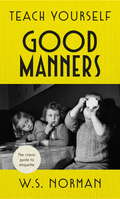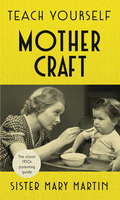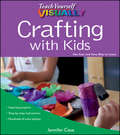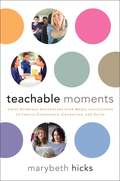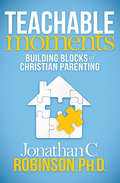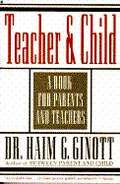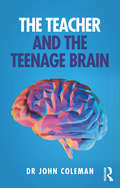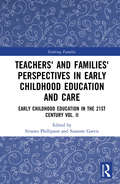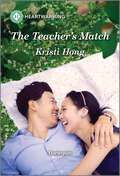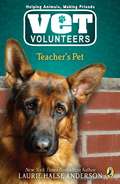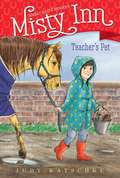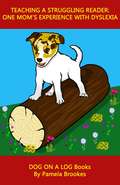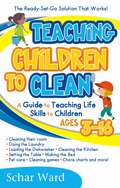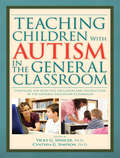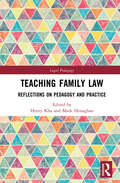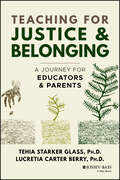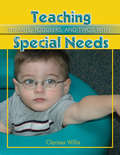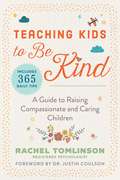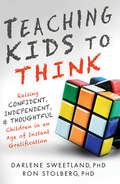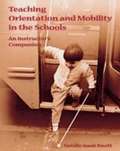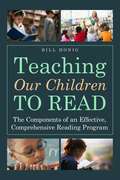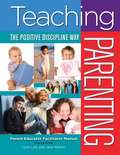- Table View
- List View
Teach Yourself Baby Names
by Victoria WilsonThis book contains more than 7,000 names from every origin, from Celtic and Sanskrit to brand-new names for the 21st century.
Teach Yourself Good Manners: The classic guide to etiquette
by W S NormanOriginally published in 1958, Teach Yourself Good Manners is a fascinating guide, packed full of both timeless advice and tips that demonstrate just how much life has changed in the 60 years since it published. Indeed, the author, W S Norman, would doubtless be horrified by modern manners and would implore us to study his rather uptight but very funny rules for modern living. Amusing, intriguing and sometimes rather inspiring, this handbook is a window into how life would have looked had we lived in a 'a simpler age' - in which, confusingly, they had rather a lot of strange rules.Since 1938, millions of people have learned to do the things they love with Teach Yourself. Welcome to the how-to guides that changed the modern world.
Teach Yourself Mothercraft
by Sister Mary MartinLearn how to have a happy baby and a happy home with this charming guide to the essentials of mothercraft. Keep yourself well, share the journey with your partner, and watch your little one with pride, developing every day under your loving care.Since 1938, millions of people have learned to the things they love with Teach Yourself. Welcome to the how-to guides that changed the modern world.FIRST PUBLISHED IN 1950.
Teach Yourself Mothercraft
by Sister Mary MartinLearn how to have a happy baby and a happy home with this charming guide to the essentials of mothercraft. Keep yourself well, share the journey with your partner, and watch your little one with pride, developing every day under your loving care.Since 1938, millions of people have learned to the things they love with Teach Yourself. Welcome to the how-to guides that changed the modern world.FIRST PUBLISHED IN 1950.
Teach Yourself Visually: Crafting with Kids
by Jennifer CasaGet creative with kids Unplugging kids from their MP3 players and game systems for one-on-one family time is a great way to reconnect in today's hectic world. And what better way to spend time together than doing an activity that's not only fun but also promotes creativity and self-expression? Teach Yourself VISUALLY Crafting with Kids is packed with step-by-step instructions for making crafts throughout the year, from outdoor projects to gifts and party favors to holiday decor to projects that promote learning through play. 75 fun, simple projects for adults to make with kids Concise, two-page lessons show you all the steps to a skill and are ideal for quick review Detailed color photos demonstrate each step and helpful tips provide additional guidance Loaded with easy-to-follow instructions and fun, simple projects, Teach Yourself VISUALLY Crafting with Kids gives parents, caregivers, and teachers the tools they need to make the most of the time they spend with kids.
Teach Yourself Yoga for Pregnancy and Birth
by Uma Dinsmore-TulliHave a healthy, happy pregnancy through yoga. Teach Yourself Yoga for Pregnancy and Birth offers you a way to stay healthy during your pregnancy and nurture your spiritual and emotional well-being. Inside you'll find breathing techniques and relaxation exercises to help during pregnancy and labor.
Teachable Moments
by Marybeth HicksNationally syndicated columnist and media advisor on all things parenting, Marybeth Hicks outlines the overarching issues and objectives in using daily encounters with the culture to impart the values and virtues of Christianity. Through entertaining and instructive questions and answers, she provides concrete examples of teachable moments that will ring true for every family.Never have Christian families been so challenged by the world around them to instill and instruct their children in the tenets of their faith. Moral relativism literally seeps into every facet of family life and saturates our popular culture. A ubiquitous media presence that defines our daily experience also is defining the attitudes and behaviors of those who consume it. Yet within this pervasive secular culture, Christian families encounter "teachable moments," those unplanned but unmatched opportunities to put their faith into action and live out the values and virtues embodied in Jesus Christ. When looking for teachable moments, parents, and coaches must approach each day with intentionality, seeking out and capitalizing on opportunities to incorporate life lessons into every day experiences amid the culture. Teachable moments might be as simple as incorporating values about empathy and compassion in young friendships, or as complex and consequential as understanding the nature of the culture's destructive messages about human sexuality. They might present themselves in song lyrics, teacher's comments, television shows, social media interactions, and current events. Most certainly, teachable moments emerge in parenting decisions, family relationships, school situations, and in opportunities for freedom and responsibility. Teachable Moments outlines the overarching issues and objectives in using daily encounters with the culture to impart the values and virtues of Christianity. Through entertaining and instructive questions and answers, author Marybeth Hicks provides concrete examples of teachable moments that will ring true for every family.
Teachable Moments: Building Blocks of Christian Parenting
by Jonathan RobinsonCommunication strategies for building a better relationship with your children, from a psychologist who has worked with families for over three decades. Are you frustrated when your child is not responsive to your efforts to be a good parent? Are you shaking your head in confusion or barking orders as a last resort in getting through to him/her? Do you wish for more quality time with your child? Parenting is the toughest job—for which most parents have no training. We tend to emulate our own parents, for good or for bad. In the Bible, Proverbs 22:6, we are told to &“train your children in the ways of the Lord, so that when they are old, they will not depart from Him.&” Teachable Moments: Building Blocks of Christian Parenting is a source book for parents and helping professionals who want both the spiritual context and the step-by-step practical parenting tools with which to be effective, engaged, Christian parents. Are you ready to move from surviving to thriving in your relationship with your children? You will learn: –Nine parenting perspectives to guide your understanding of your child –How communication defines relationship and the four distinct types of communication to use when your child is not having problems –Eleven specific communication tools and behavior management strategies, and more The author, a licensed clinical psychologist with decades of experience in practice, also includes &“Learn the Concept&” exercises embedded within the chapters—so you can practice these tools and strategies and start enjoying a better relationship with your children today.
Teacher and Child: A Book for Parents and Teachers
by Haim G. GinottGives both the teachers and parents an insight to psychological problem children encounter in everyday situation.
The Teacher and the Teenage Brain
by John ColemanThe Teacher and the Teenage Brain is essential reading for all teachers and students of education. This book offers a fascinating introduction to teenage brain development and shows how this knowledge has changed the way we understand young people. It provides a critical insight into strategies for improving relationships in the classroom and helping both adults and teenagers cope better with this stage of life. Dr John Coleman shows how teachers and students can contribute to healthy brain development. The book includes information about memory and learning, as well as guidance on motivation and the management of stress. Underpinned by his extensive work with schools, Dr Coleman offers advice on key topics including the importance of sleep, the social brain, moodiness, risk and risk-taking and the role of hormones. This book is extensively illustrated with examples from classrooms and interviews with teachers. It explicitly links research and practice to create a comprehensive, accessible guide to new knowledge about teenage brain development and its importance for education. Accompanied by a website providing resources for running workshops with teachers and parents, as well as an outline of a lesson plan for students, The Teacher and the Teenage Brain offers an innovative approach to the understanding of the teenage brain. This book represents an important contribution to teacher training and to the enhancement of learning in the classroom.
Teachers' and Families' Perspectives in Early Childhood Education and Care: Early Childhood Education in the 21st Century Vol. II (Evolving Families)
by Sivanes Phillipson Susanne GarvisThe second volume in this Early Childhood Education in the 21st Century: International Teaching, Family and Policy Perspectives miniseries focuses on teacher and family perspectives of early childhood education and care from 19 different countries around the world. The aim of this volume is to articulate the key components of teacher education and family practices that impact young children’s education and care. Each country featured in this volume presents its own unique perspective in relation to the cultural and societal constraints around teacher training and/or family practices and the thinking around those practices that are important for early childhood development. Offering a unique insight into how teachers and families work together in different countries, the book is essential reading for early childhood educators, researchers, early childhood organisations, policy makers and those interested to know more about early childhood within an international perspective.
The Teacher's Match: A Clean and Uplifting Romance
by null Kristi HongA new career. A new school.And a very inconvenient new crush. Joanna Lin is determined to avoid her mother&’s matchmaking. With a new career as an art teacher at a Mandarin immersion school, Joanna refuses to let anything or anyone distract her. Especially her charming new colleague Jack Sun. His kindness and passion for teaching—not to mention those dimples!—are practically irresistible. But anything beyond friendship is impossible, especially when Jack&’s moving to Taiwan at the end of the school year. But as spring—and the school&’s Dragon Boat Festival—draws closer, love might send all of their careful plans tumbling overboard.From Harlequin Heartwarming: Wholesome stories of love, compassion and belonging.
Teacher's Pet: Maggie (Vet Volunteers #7)
by Laurie Halse AndersonMaggie's still getting used to middle school. One of her teachers is, too - Mr. Carlson, her new science teacher, is blind, and is working with a guide dog for the first time. Scout is a love of a German shepherd and really wants to do his job, but Maggie can tell that Mr. Carlson's still having a hard time. Maybe she can help. . . .
Teacher's Pet
by Judy Katschke Serena GeddesA back-to-school assignment has Willa scrambling in this seventh book of a chapter book series inspired by Marguerite Henry’s Misty of Chincoteague.Willa just started school again and everyone in her class has come up with clever ideas for their back-to-school projects. Even her best friends Lena and Sarah are preparing something different: a Double-Dutch demonstration. At first Willa thinks her father’s fabulous raspberry torte will be perfect, but at the last minute, the raspberries don’t cooperate! Just in the nick of time she realizes the best idea is in her own barnyard: Starbuck! She’ll show her class how to groom him, something she’s an expert at!
Teaching a Struggling Reader: One Mom's Experience with Dyslexia (DOG ON A LOG Books #1)
by Pamela BrookesThere are a lot of children (and adults) who struggle with reading. Some are helped by their schools, some are not. <P><P>In this short booklet, Pamela Brookes shares some of the basic information she wishes she'd had when she was first trying to figure out how to help her child learn to read. <P><P>Teaching A Struggling Reader is filled with links to informational and product resources for parents or teachers. It is geared to people who want to educate themselves in the methods that are effective in teaching those with dyslexia. It also contains photos demonstrating basic techniques like "Tapping" (using one's fingers to aid in sounding out words) and "Making your bed" to differentiate between "b" and "d." <P><P>This Second Edition includes new information and new links. Most importantly it has information on Early Intervention, including what parents can do if they suspect their child may have dyslexia during the toddler and preschool years, and a new section on What if It's NOT Dyslexia. <P><P>The focus of this book is the reading process. However, since many readers with dyslexia also struggle with math, there is a brief description of how the dyslexic brain comes to understand math. There is also a link to a blog by Dr. Meg Burke of Dyslexia Pros. She has dyslexia and a PhD in math education. She is dedicated to helping her students attain fluency in math. <P><P>This is a booklet that can be read in one sitting. However, there are ample links to provide an even greater experience.
Teaching Children to Clean: The Ready-Set-Go Solution That Works!
by Schar WardThis book contains step-by-step instructions for teaching children and teenagers to clean an entire house. Plus many other life skills such as doing laundry, loading a dishwasher properly, and making a bed. Cleaning is not an option, it's a necessity! If your child doesn't learn, it'll plague them the rest of their lives. According to the latest research, teaching your child to clean may be the most important thing you ever do for them! You want your child to learn basic life skills, but finding the time for accomplishing this seems to get more difficult each day. What's the answer? A new approach, that practically does it for you! You'll find it in these pages and even more: * The research on children & cleaning * Proven tactics to get the job done * Chore charts for every age * Room evaluations for easier cleaning * What tools they need * Safe green cleaning solutions, you can make yourself * Checklists for detailed cleaning in very room * How to clean appliances * How to do laundry, set the table and everyday chores * How to take care of pets * Fun cleaning games. Knowing how to take care of yourself in your everyday environment is a skill no one should be without!
Teaching Children With Autism in the General Classroom
by Vicky G. Spencer Cynthia G. SimpsonSuccessful strategies for educating students with autism in the regular classroom. Recent special education legislation has led to a rise in inclusion classrooms, where students with special needs, including autism spectrum disorders, are taught alongside their nondisabled peers. Teaching Children with Autism in the General Classroom provides an introduction to inclusionary practices that serve children with autism, giving teachers the practical advice they need to ensure each student receives the quality education he or she deserves. Promoting field-tested strategies and techniques, this book offers teachers sound advice for creating a classroom environment conducive to learning success for children with autism spectrum disorders. The easy-to-use tips and tools included also aide teachers in organizing and managing their classrooms to maximize instruction for students of all ability levels. Detailed resource guides and concise overviews of special education legislation also are provided to give general education teachers a solid background of knowledge about autism and the needs of students with the disorder.
Teaching Family Law: Reflections on Pedagogy and Practice (Legal Pedagogy)
by Henry Kha and Mark HenaghanThis book provides a comprehensive analysis of the teaching of an eclectic range of family law topics and the unique opportunities and challenges of teaching family law in different jurisdictions from a varied international perspective. Written by leading legal scholars, the book addresses a gap in the scholarship to comprehensively and systematically analyse the teaching of family law. The first part of the book explores ways of teaching the varied range of topics under the heading of family law and captures the diverse approaches to the discipline. Chapters illustrate how the subject can be best taught in an interdisciplinary way that considers feminist perspectives and the philosophy of teaching, while encompassing legal positivism, empirical research and critical legal theory. The second part of the book examines teaching in different jurisdictions and illustrates policy and practice in Australia, New Zealand, the United States, Canada, the United Kingdom, Hong Kong and South Africa. Showcasing examples of best practice of teaching family law, the book will be an essential reading for legal scholars, as well as researchers and postgraduate students in the fields of family law and legal education.
Teaching for Justice & Belonging: A Journey for Educators and Parents
by Tehia Starker Glass Lucretia Carter BerryCreate a classroom with a culture of true belonging, liberation, and justice for all Teaching for Justice and Belonging: A Journey for Educators & Parents provides a practical and powerful blueprint to unrooting racism in the educational setting. The book is an easy-to-understand guide designed to cultivate an educational experience that inspires a culture of true belonging, liberation, and justice for all. Relying on case studies, thorough research, and deeply personal and enlightening experiences drawn from the lives of the authors themselves, Teaching for Justice and Belonging also offers: Demonstrations of how to explore personal and collective racial identity to learn more about oneself and others Support for making systemic change within the spheres of influence of educators and parents Real testimonials and stories to guide readers on their own healthy anti-racism journeys A central piece of any anti-racism roadmap, this book is perfect for K-12 educators, administrators, and teacher leaders. It will also earn a place in the bookshelves of pre-service teachers and parents interested in unlearning racism and encouraging diverse voices in the education system.
Teaching Infants, Todders & Twos with Special Needs
by Clarissa WillisPlacing children with special needs in environments that include typically developing peers has become commonplace as continuing research confirms that all children benefit and learn from each other as well as from their teachers. Teaching Infants, Toddlers, and Twos with Special Needs is written for all teachers and directors who work with infants, toddlers, and twos, including special educators and educators working with typically developing children. This book specifically addresses the needs of children with developmental delays, as well as children at risk for developing special needs. Each chapter in Teaching Infants, Toddlers, and Twos with Special Needs includes information about how young children learn. The strategies and adaptations in each chapter are easy to use and apply to all children. Examples are presented for managing the physical environment and for teaching skills that will enhance the overall development of infants, toddlers, and twos with special needs.
Teaching Kids to Be Kind: A Guide to Raising Compassionate and Caring Children
by Rachel TomlinsonA simple and sweet parenting book with 365 tips—a new one to try every day! As a parent, you want the best for your child, and one of your greatest hopes is that your child will grow up to be a good person. So, what makes a good person? Generally, we think about good people as being kind: those who are compassionate, empathetic, generous. However, it seems that, in our fast-paced, individual-driven society, kindness is fading and the pressure on parents to raise socially conscious, empathetic, and caring children can seem overwhelming at times.In Teaching Kids to Be Kind, Rachel Tomlinson draws from her professional experiences to provide 365 inspiring strategies to help children and families practice kindness every day of the year. Daily tips include:Taking your child shopping around the holidays to select a new toy to donate to another little boy or girl their age.Leaving little notes in their lunch box or school bag for them to find. This models unconditional love and consideration for others.Baking a cake together to teach patience and teamwork and build on their ability to delay gratification. An essential tool for parents, Teaching Kids to Be Kind will help children develop empathy, regulate their emotions, and improve their general well-being as well as support families in strengthening their overall relationships.
Teaching Kids to Think
by Darlene Sweetland Ron StolbergWhy Do Kids These Days Expect Everything to be Given to Them?Today's kids don't know how to read a map. They can Google the answer to any question at lightning speed. If a teen forgets his homework, a quick call to mom or dad has it hand-delivered in minutes. Fueled by the rapid pace of technology, the Instant Gratification Generation not only expects immediate solutions to problems--they're more dependent than ever on adults. Today's kids are being denied opportunities to make mistakes, and more importantly, to learn from them. They are being taught not to think.In Teaching Kids to Think, Dr. Darlene Sweetland and Dr. Ron Stolberg offer insight into the social, emotional, and neurological challenges unique to this generation. They identify the five parent traps that cause adults to unknowingly increase their children's need for instant gratification, and offer practical tips and easy-to-implement solutions to address topics relevant to children of all ages.A must-read for parents and educators, Teaching Kids to Think will help you understand where this sense of entitlement comes from--and how to turn it around in order to raise children who are confident, independent, and thoughtful.
Teaching Orientation and Mobility in the Schools: An Instructor's Companion
by Natalie Isaak KnottTeaching Orientation and Mobility in the Schools: An Instructor's Companion offers orientation and mobility (O&M) instructors and professionals working with students with visual impairments insights and advice. The book offers creative instructional methods and practical strategies as well as useful forms and checklist.
Teaching Our Children to Read: The Components of an Effective, Comprehensive Reading Program
by Bill HonigStudies of effective teaching practices have continued to validate the need for explicit and systematic instruction in basic reading skills, and Bill Honig uses this research to shed new light on an old problem-how to help all students become fluent readers. Teaching Our Children to Read grows out of the experiences of scores of dedicated teachers and their success in the classroom. This book explores current research from the leading experts in the field, and presents new instructional strategies that bring all students to higher levels of literacy.Highlights from Teaching Our Children to Read include: Phonics instruction and fluency Connected practice with decodable text Multisyllabic word instruction Spelling, vocabulary, and concept development Strategic reading, book discussions, and text organization Literacy benchmarks, assessment, and interventionThis is an essential resource for educators, administrators, policymakers, and parents concerned about how to successfully teach our children to read. Teaching Our Children to Read points the way to implementing the best research-based practices in adopting reading materials, training teachers, and providing the necessary school leadership.
Teaching Parenting: The Positive Discipline Way
by Jane Nelsen Lynn LottTeaching Parenting the Positive Discipline Way (developed by Lynn Lott and Jane Nelsen) is a research-based parent education program that provides a step-by-step approach to starting and leading experientially based parenting groups.

